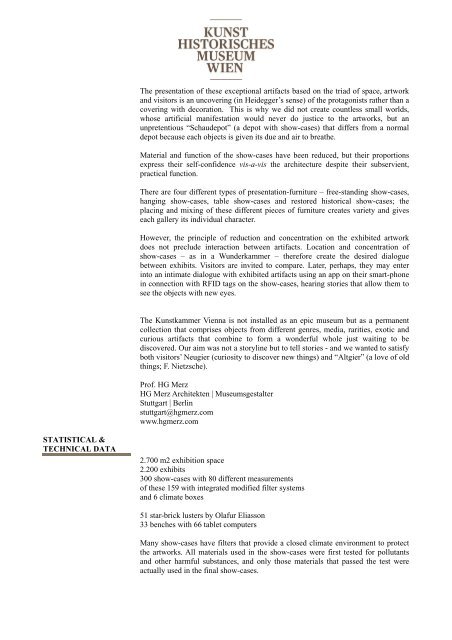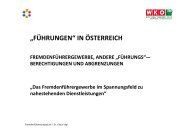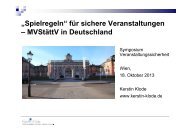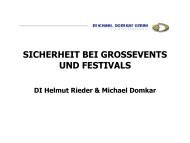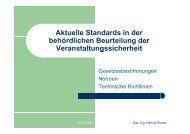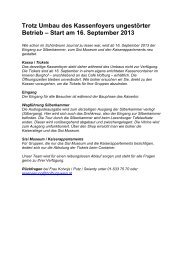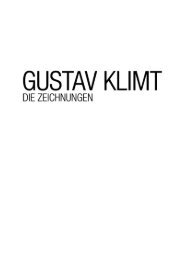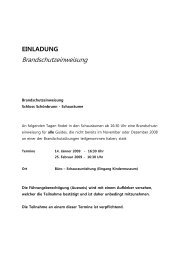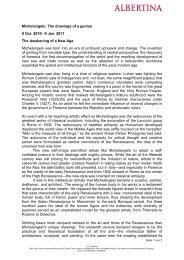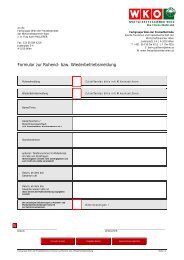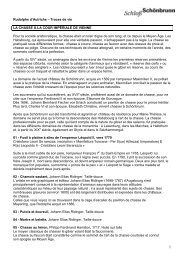kunstkammer vienna the cradle of the museum - Freizeitbetriebe ...
kunstkammer vienna the cradle of the museum - Freizeitbetriebe ...
kunstkammer vienna the cradle of the museum - Freizeitbetriebe ...
Create successful ePaper yourself
Turn your PDF publications into a flip-book with our unique Google optimized e-Paper software.
STATISTICAL &<br />
TECHNICAL DATA<br />
The presentation <strong>of</strong> <strong>the</strong>se exceptional artifacts based on <strong>the</strong> triad <strong>of</strong> space, artwork<br />
and visitors is an uncovering (in Heidegger’s sense) <strong>of</strong> <strong>the</strong> protagonists ra<strong>the</strong>r than a<br />
covering with decoration. This is why we did not create countless small worlds,<br />
whose artificial manifestation would never do justice to <strong>the</strong> artworks, but an<br />
unpretentious “Schaudepot” (a depot with show-cases) that differs from a normal<br />
depot because each objects is given its due and air to brea<strong>the</strong>.<br />
Material and function <strong>of</strong> <strong>the</strong> show-cases have been reduced, but <strong>the</strong>ir proportions<br />
express <strong>the</strong>ir self-confidence vis-a-vis <strong>the</strong> architecture despite <strong>the</strong>ir subservient,<br />
practical function.<br />
There are four different types <strong>of</strong> presentation-furniture – free-standing show-cases,<br />
hanging show-cases, table show-cases and restored historical show-cases; <strong>the</strong><br />
placing and mixing <strong>of</strong> <strong>the</strong>se different pieces <strong>of</strong> furniture creates variety and gives<br />
each gallery its individual character.<br />
However, <strong>the</strong> principle <strong>of</strong> reduction and concentration on <strong>the</strong> exhibited artwork<br />
does not preclude interaction between artifacts. Location and concentration <strong>of</strong><br />
show-cases – as in a Wunderkammer – <strong>the</strong>refore create <strong>the</strong> desired dialogue<br />
between exhibits. Visitors are invited to compare. Later, perhaps, <strong>the</strong>y may enter<br />
into an intimate dialogue with exhibited artifacts using an app on <strong>the</strong>ir smart-phone<br />
in connection with RFID tags on <strong>the</strong> show-cases, hearing stories that allow <strong>the</strong>m to<br />
see <strong>the</strong> objects with new eyes.<br />
The Kunstkammer Vienna is not installed as an epic <strong>museum</strong> but as a permanent<br />
collection that comprises objects from different genres, media, rarities, exotic and<br />
curious artifacts that combine to form a wonderful whole just waiting to be<br />
discovered. Our aim was not a storyline but to tell stories - and we wanted to satisfy<br />
both visitors’ Neugier (curiosity to discover new things) and “Altgier” (a love <strong>of</strong> old<br />
things; F. Nietzsche).<br />
Pr<strong>of</strong>. HG Merz<br />
HG Merz Architekten | Museumsgestalter<br />
Stuttgart | Berlin<br />
stuttgart@hgmerz.com<br />
www.hgmerz.com<br />
2.700 m2 exhibition space<br />
2.200 exhibits<br />
300 show-cases with 80 different measurements<br />
<strong>of</strong> <strong>the</strong>se 159 with integrated modified filter systems<br />
and 6 climate boxes<br />
51 star-brick lusters by Olafur Eliasson<br />
33 benches with 66 tablet computers<br />
Many show-cases have filters that provide a closed climate environment to protect<br />
<strong>the</strong> artworks. All materials used in <strong>the</strong> show-cases were first tested for pollutants<br />
and o<strong>the</strong>r harmful substances, and only those materials that passed <strong>the</strong> test were<br />
actually used in <strong>the</strong> final show-cases.


